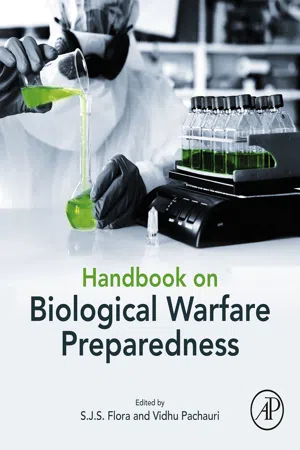History of biological warfare agents
Infectious diseases and war are always interlinked. Even without a precise understanding of how diseases were spread, it was understood early that dead animals or humans could cause disease. There are some accounts of biological warfare in the form of poison on arrows, and polluting wells and other source of water by opposing armies. However, apart from some rare well-documented events (Eitzen and Takafuji, 1997) it is often very difficult for historians and microbiologists to understand natural epidemics from alleged biological attacks, because little information is available for times before the advent of modern microbiology and the passage of time may also have distorted the reality of the past. Evidence from Persian, Greek, and Roman literature suggests the use of animal cadavers to contaminate wells and other sources of water around 300 BC, and in 400 BC, Scythian archers infecting their arrows by dipping them in decomposing bodies or in blood mixed with manure. In 190 BC during the Battle of Eurymed, Hannibal won a naval victory over King Eumenes II of Pergamon by firing earthen vessels full of venomous snakes onto the enemy ships. In the 12th century AD, during the battle of Tortona, Barbarossa used the bodies of dead soldiers to poison wells. During the siege of Caffa, a well-fortified Genoese-controlled seaport (now Feodosia, Ukraine), in 1346, the attacking Tartar force experienced an epidemic of plague (Wheelis, 2002). The Tartars threw the cadavers of their deceased into the city, and it is believed that this has initiated a plague epidemic in the city. The outbreak of plague forced the retreat of the Genoese forces. The plague pandemic known as the Black Death spread throughout Europe, the Near East, and North Africa in the 14th century and was probably the most devastating public health disaster in recorded history. The ultimate origin of the plague remains uncertain: several countries in the Far East, China, Mongolia, India, and Central Asia have reported these instances in the past (Rauw, 2012). The biological warfare attack in Caffa is one of the terrible consequences in history when diseases were used as weapons.
During the battle between Russian and Swedish forces at Reval in Estonia in 1710, catapulted plague cadavers were used. In the 18th century, during the French and Indian War, British forces in North America gave blankets from smallpox patients to the Native Americans to transmit the disease to the immunologically naïve tribes. In 1863, a Confederate surgeon was arrested and charged with attempting to import yellow fever-infected clothes into northern parts of the United States during the Civil War (Hunsicker, 2006). Biological warfare became more sophisticated against both animals and humans during the 1900s. The conception of Koch’s postulates and the development of modern microbiology during the 19th century made possible the isolation and production of stocks of specific pathogens (Robertson and Robertson, 1995). During World War I (WWI), some reports have suggested that the Germans developed horses and cattle inoculated with disease-producing bacteria, such as Bacillus anthracis (anthrax) and Pseudomonas pseudomallei (glanders), and shipped them to the United States, Russia, and other countries (Hugh-Jones); although Germany denied these reports. In 1924, a subcommittee of the Temporary Mixed Commission of the League of Nations found no hard evidence that bacteriological weapons had been employed in war. On June 17, 1925, the “Protocol for the Prohibition of the Use in War of Asphyxiating, Poisonous or Other Gases and of Bacteriological Methods of Warfare,” commonly called the Geneva Protocol of 1925, was signed. Because viruses were not differentiated from bacteria at that time, they were not specifically mentioned in the protocol. A total of 108 nations, including the five permanent members of the United Nations (UN) Security Council, eventually signed the agreement. However, the Geneva Protocol did not address verification or compliance, making it a “toothless” and less meaningful document. Several countries that were parties to the Geneva Protocol of 1925 began to develop biological weapons soon after its ratification. These countries included Belgium, Canada, France, Great Britain, Italy, the Netherlands, Poland, Japan, and the Soviet Union. The United States did not ratify the Geneva Protocol until 1975 (Riedel, 2004).
Biological agents to cause destruction have been used since 6th century BC, wherein it was the poisoning of wells and water supplies that was most common. The very first deliberate act of spreading disease occurred in 1346 at the Siege of Caffa (Feodosia, Ukraine), when a Tartar army disposed its plague-ridden dead over the walls of the besieged city (Wheelis, 2002). Later, in 1763, during the French and Indian war, an English general intentionally distributed blankets contaminated with small pox scabs to the Native Americans loyal to the French, which caused a huge epidemic to kill the tribal people. The Germans als...
